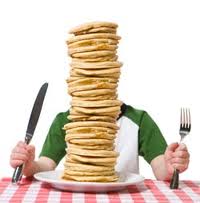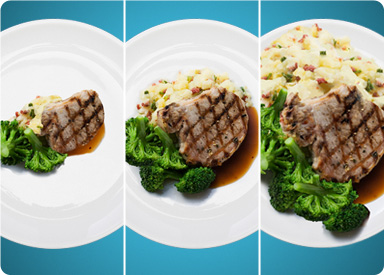Portion Distortion: Growing up, mom may have taught you to not leave the dinner table until your plate was clean. Well, it’s that mentality still sticking in the minds of Americans today. Unfortunately, the plate we fill has grown about 36% , portion sizes at restaurants has grown up to 50%, servings sizes in packages have grown up
 to 40%, and food hasn’t necessarily improved in nutritional quality. (1, 2, 3) As a result, Americans are filling up on way more calories than they recognize developing dangerously large waistlines and increasing the risk of chronic disease. To take matters into your own hands and to help prevent overeating try switching to serving yourself on a salad plate, use smaller silverware to control bite size, and switch out large cups and bowls for smaller child sizes. Also, the FDA has just switched over from the Pyramid to the Plate Method to describe how one should be filling their plate. It suggests that you fill half of your plate with fruits and veggies, split the other half between whole grains and lean protein, and have skim dairy as well. Below is the daily allotment of each of the food groups recommended for the average adult and their size in relation to common items. Use it as a tool to help you control portion size and calories to keep your waist slim!
to 40%, and food hasn’t necessarily improved in nutritional quality. (1, 2, 3) As a result, Americans are filling up on way more calories than they recognize developing dangerously large waistlines and increasing the risk of chronic disease. To take matters into your own hands and to help prevent overeating try switching to serving yourself on a salad plate, use smaller silverware to control bite size, and switch out large cups and bowls for smaller child sizes. Also, the FDA has just switched over from the Pyramid to the Plate Method to describe how one should be filling their plate. It suggests that you fill half of your plate with fruits and veggies, split the other half between whole grains and lean protein, and have skim dairy as well. Below is the daily allotment of each of the food groups recommended for the average adult and their size in relation to common items. Use it as a tool to help you control portion size and calories to keep your waist slim!

- Grains: Adults need about 6-8 ounce equivalents per day
- ½ cup cooked oatmeal = the size of half a tennis ball counts as 1 oz equivalent
- ½ cup cooked rice or pasta = the size of a cupcake wrapper full counts as 1 oz equivalent
- 1 pancake = the size of a CD counts as 1 oz equivalent
- 2 oz slice of bread = the size of a Great Harvest slice of bread counts as 2 oz equivalents
- Vegetables: Adults need about 2 ½ - 3 cups per day
- 1 cup raw spinach = the size of a baseball and counts as ½ cup veggies
- 1 cup cooked broccoli = the size of an ice cream scoop counts as ½ cup veggies
- 1 bake sweet potato = the size of a computer mouse counts as 1 cup veggies
- ½ cup tomato juice = the size of a dining room coffee cup counts as ½ cup veggies
- Fruit: Adults need about 1 ½ -2 cups per day
- ½ cup juice or fruit cocktail = ½ baseball counts as ½ cup fruit
- 1 cup of cut up fruit = the size of a fist counts as ½ cup fruit
- 1 cup of fruit = 1 banana, 1 apple, 1 grapefruit, 1 peach, 2 small oranges
- ¼ cup raisins = the size of a large egg counts as ½ cup fruit
- Dairy: Adults need About 3 cups per day
- 1 cup milk or soy milk = the size of a small carton counts as 1 cup dairy
- 1 cup of yogurt = the size of a regular 8 oz yogurt container counts as 1 cup dairy
- 2 slices of cheese = the size of 2 packs of gum counts as 1 cup dairy
- ½ cup frozen yogurt = the size of half a baseball counts as ½ cup dairy
- Protein Adults need about 5-6 ½ ounce equivalents per day
- 3 oz cooked meat = the size of a deck of cards
- 1/2 cup cooked beans = the size of half a baseball counts as 2 oz of protein and ½ cup veggies
- 3 oz cooked chicken = the size of a chicken leg, thigh, or breast
- 3 oz grilled fish = the size of a check book
If you feel hungry even with these smaller sizes try drinking more water before your meal, eating broth based soup or load up on extra non starchy vegetables like broccoli, salad greens, roasted red tomatoes, or green beans! Visit MyPlate.gov to find your individualized plan.
What methods do you use for portion control?
References:
1.) Wansink B. Mindless Eating: Why We Eat More Than We Think. New
` York, NY: Bantam Dell; 2006.
2.) Rolls BJ. The supersizing of America: Portion size and the obesity
epidemic. Nutr Today. 2003;38:42-53
3.) 11. Wansink B. Can package size accelerate usage volume? J Marketing.
1996;60:1-14



